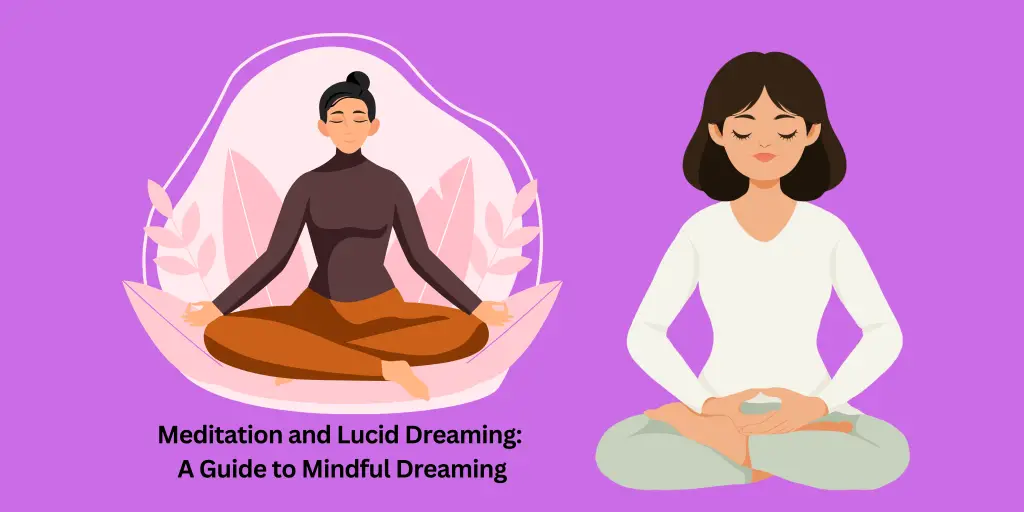
Welcome to the wonderful world of lucid dreaming! Have you ever wanted to take control of your dreams and explore a new realm in your sleep?
Well, with meditation, you can do just that. In this blog article, We’ll discuss how meditation can help unlock your dreams and give you the power to induce lucid dreaming.
So what is lucid dream meditation?
Lucid dream meditation is a type of meditation that allows you to become aware of your thoughts and feelings while you are sleeping. It is a dream over which you have complete awareness and control.
While you meditate, you should concentrate on your breathing and try to push all other thoughts and feelings out of your mind. You also calm both your body and mind, which enables you to enter a state of profound reflection on your experience.
This calm state can be particularly beneficial to lucid dreaming since it helps to bring about a heightened feeling of awareness and intentional dreaming. Lucid dreaming can be described as dreaming with the awareness that one is dreaming.
As we sleep, our thoughts frequently jump from one topic to another; but, when we meditate, we train our attention to remain fixed on a single concept or notion.
But did you know that meditation may be able to help you achieve this state?
Meditation has been used for centuries as a way to relax, focus your thoughts, and even improve physical health.
However, it may also have some unexpected benefits when it comes to achieving lucidity during dreams.
Studies suggest that regular meditation can increase awareness during sleep – making it easier for someone to become conscious while dreaming – as well as improving dream recall after waking up from sleep.
So how does this work exactly?
Well, when we meditate we practice focusing on our breath or repeating mantras in order to quiet our minds and enter into a relaxed state of consciousness known as “theta wave activity.”
This same type of brainwave activity occurs naturally during REM (rapid eye movement) sleep – which is when most dreams occur – so by practicing mindfulness regularly throughout the day we can train ourselves how to remain conscious while sleeping at night!
In addition, research suggests that certain types of meditation such as transcendental or mantra-based practices can actually induce lucid dreams more quickly than other forms of mental training alone would do so!
What is the Link Between Meditation and Lucid Dreaming?
Lucid dreaming occurs when we are conscious of our dreams, allowing us to control what happens in them.
By practicing meditation regularly, we can learn how to access this state more easily by becoming familiar with the sensations associated with it – such as feeling relaxed yet alert at the same time – while meditating during wakefulness.
The practice of mindfulness meditation has been found particularly helpful in inducing lucid dreams due to its focus on being present in each moment without judgment or expectation;
This allows for greater clarity during dream states which makes it easier for one’s subconscious mind to recognize that they are indeed dreaming while still asleep!
With regular practice, anyone can learn how to tap into their own inner potential through mindful exploration via both waking life and dream states alike – unlocking new levels of creativity and self-awareness along the way!
How to Induce Lucid Dreaming Through Meditation?
Lucid dreaming is an incredible experience that allows us to explore our innermost thoughts and feelings, as well as the depths of our imagination.
But how do we induce this state of consciousness? The answer may surprise you – meditation!
Meditation has long been used for its calming effects on both body and mind. However, it can also be used to induce lucid dreams.
By focusing on relaxation techniques such as deep breathing exercises or visualization during meditation sessions, one can increase their chances of having a lucid dream.
Additionally, practicing mindfulness throughout the day will help keep your awareness sharp when you enter into REM sleep at night – increasing your likelihood of becoming conscious within the dream state.
If you’re looking for an exciting way to explore yourself and expand your horizons while asleep – then learning how to induce lucid dreaming through meditation could be just what you need!
Not only will it open up a whole new realm of possibilities but it’s also incredibly easy (and fun!) once mastered correctly.
Can meditation cause lucid dreaming?
The answer is yes! According to studies, daily meditation may improve sleep awareness and make it simpler for someone to awaken from a dream.
Through conscious examination of both waking life and dream states, anyone can eventually learn how to produce lucid dreams, developing new levels of creativity and self-awareness along the way.
One can improve their chances of experiencing a lucid dream by concentrating on relaxation methods during meditation sessions, such as deep breathing exercises or visualization.
Also, staying vigilant throughout the day will aid in maintaining your consciousness as you go into REM sleep at night, boosting the likelihood that you will awaken from your dreams.
What are the Benefits of Meditating for Lucid Dreaming?
Meditation is a powerful tool that can help us gain insight into our subconscious minds, allowing us to become more aware of our dream states.
Here are the benefits of meditating for lucid dreams:
Higher dream recollection
You can increase your awareness of what occurs in the dream state by bringing mindfulness practices into your regular life.
Greater relaxation
It can be helpful to use meditation to help you achieve the high level of physical and mental calm needed for lucid dreaming.
More understanding
You can better grasp who you are and how your mind works by meditating, and this information can be carried into your dreams to give you more awareness there.
Creative investigation
During meditation, you can communicate consciously with your subconscious to explore fresh concepts and viewpoints that could result in more imaginative lucid dreams.
With regular practice, we can learn how to recognize when we are dreaming and even influence the outcome of our dreams.
So how do you get started?
Well, there are several steps you will need to take to ensure success.
First step: With Patience
Well firstly it’s important to understand that meditation isn’t about ‘forcing’ yourself into a dream state or trying too hard; instead, it should be approached with patience and curiosity.
Start by finding somewhere comfortable where you won’t be disturbed for 10-15 minutes each day (or longer if possible).
Second step: Focusing on your breath
Then begin focusing on your breath – inhaling deeply through your nose and exhaling slowly out through your mouth – while letting go of any thoughts or worries from the day ahead.
As time passes try visualizing yourself in different scenarios such as walking along a beach or floating above clouds until eventually, these images will start appearing in your dreams!
Third step: Consistency
The key thing here is consistency; make sure you set aside some time every day for this practice so that over time it becomes part of who you are rather than something extra added onto an already busy schedule.
Once mastered however there’s no limit to what kind of adventures await within the realm of lucid dreaming – giving us access not only to greater understanding but also potential solutions which may have otherwise remained hidden away from view!
Tips on Using Meditation for Lucid Dreaming
Are you looking to achieve clarity in your sleep? Meditation can be a great way to help you reach that goal.
With meditation, this state can be achieved more easily and with greater success. Here are some tips on how to use meditation for lucid dreaming:
1) Start by setting an intention before going to bed each night
This will help focus your mind on achieving lucidity during sleep.
2) Practice mindfulness throughout the day
It’s important to stay mindful of what’s happening around you so that when it comes time for bed, your mind is already primed for lucid dreaming.
3) Create a calming environment before going to bed
Dim lights or light candles, listen to soothing music or nature sounds; whatever helps create a peaceful atmosphere conducive towards relaxation and restful sleep.
4) Engage in breathing exercises before sleeping
Take deep breaths through the nose and exhale slowly through the mouth; this will calm both body and mind which will make it easier for lucid dreams to occur naturally during REM cycles of sleep.
5) Visualize yourself as being asleep
Imagine yourself lying down comfortably in bed with no distractions or worries; visualize yourself drifting off into dreamland peacefully without any outside interference from external sources such as noise or light pollution etc.
This exercise should help relax both body & mind even further which increases the chances of having successful lucid dreams!
6 ) Focus on one thing at a time
Try not thinking about anything else but just focusing on one thing like counting sheep (or stars!) until eventually falling asleep naturally without any effort whatsoever!
This technique has been proven effective by many people who have successfully used it to achieve clarity within their own dream states!
By following these simple steps regularly over time, you should start seeing results soon enough!
Final thoughts
It may take some time to learn how to employ meditation to induce lucid dreaming, but in the end, the time and effort put in will undoubtedly be well worth it.
When you are able to reach this dream-like state, you open up a whole new world of possibilities that can help you get insight into your own life as well as the lives of those around you.
This knowledge can help you make better decisions in both your own life and the lives of those around you.
Try out some meditation for lucid dreaming if you’re looking for a method that’s not only risk-free but also beneficial to your mental well-being so that you may delve deeper into your own consciousness.







